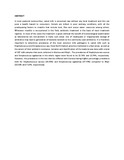The prevalence of common milk borne pathogens of camelus mastitis origin and their antibiotic resistance in north eastern province, Kenya

View/
Date
2014Author
Gitao, G C
Wanjohi, M
Gitari, R
Akweya, B
Language
enMetadata
Show full item recordAbstract
In most pastoral communities, camel milk is consumed raw without any heat treatment and this can pose a health hazard to consumers. Camels are milked in poor sanitary conditions, with all the predisposing factors to mastitis that include dust, flies and scarce water resources among others. Whenever mastitis is encountered in the field, antibiotic treatment is the basis of most treatment regimes. In most of the cases the treatment is given without the benefit of bacteriological examination as laboratories are non-existent in many such areas. Use of inadequate or inappropriate dosage of antibiotics may lead to generation of bacteria resistant to the commonly used antibiotics. It is therefore important to determine prevalence of the most common milk pathogens in camel milk such as Staphylococcus and Streptococcus spp, from North Eastern province marketed in urban areas, as well as the extent of their antibiotic resistance. Isolation and identification of the bacteria was done with a total of 207 milk samples that were collected in Garissa and Wajir.. The prevalence of Staphylococcus aureus and Streptococcus agalactiae in the whole region were found to be 22.76% and 22.74%, respectively. However, the prevalence in the two districts differed with Garissa having higher percentage prevalence both for Staphylococcus aureus (34.95%) and Streptococcus agalactiae (37.79%) compared to Wajir (10.58% and 7.69%, respectively).
Publisher
University of Nairobi
